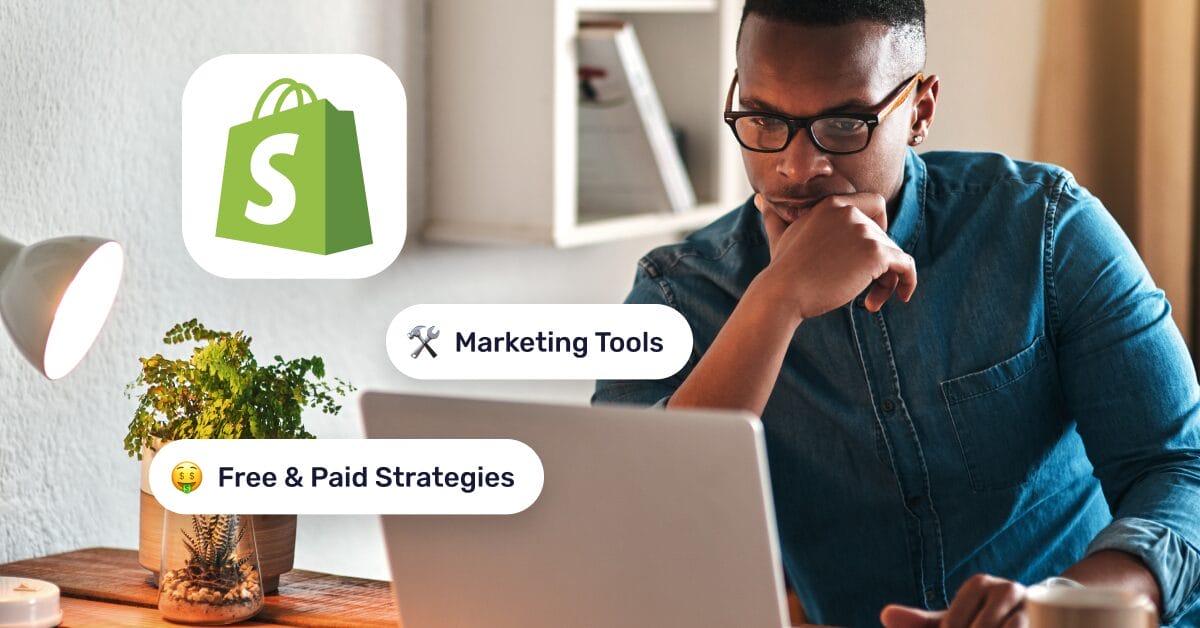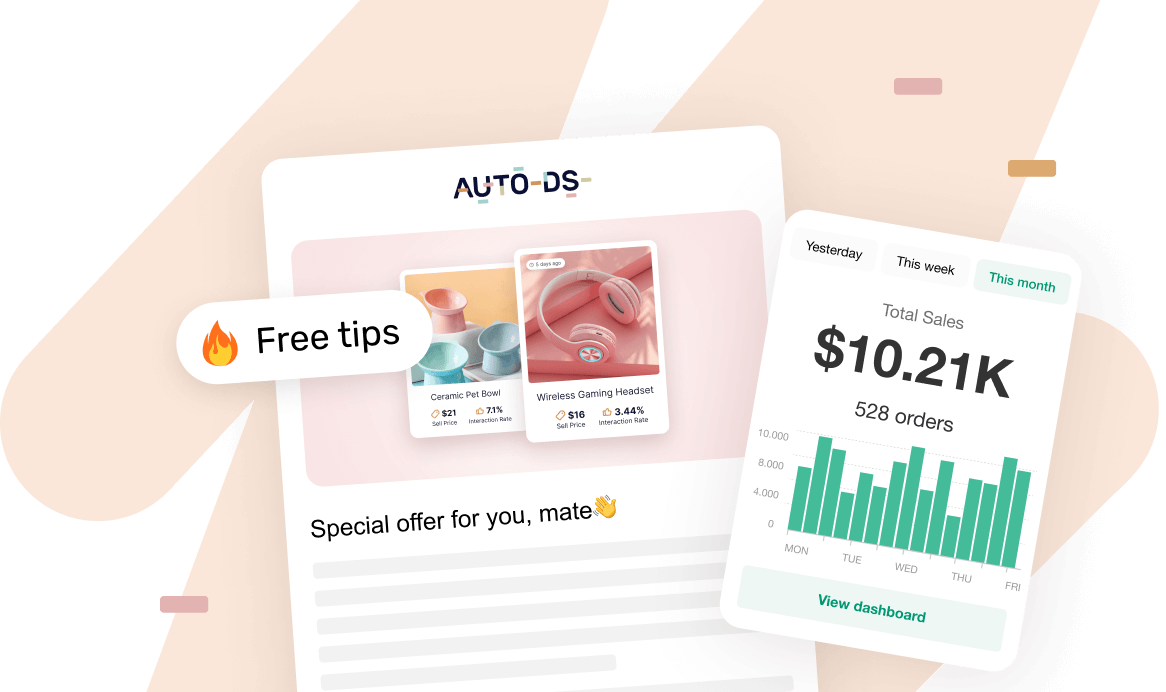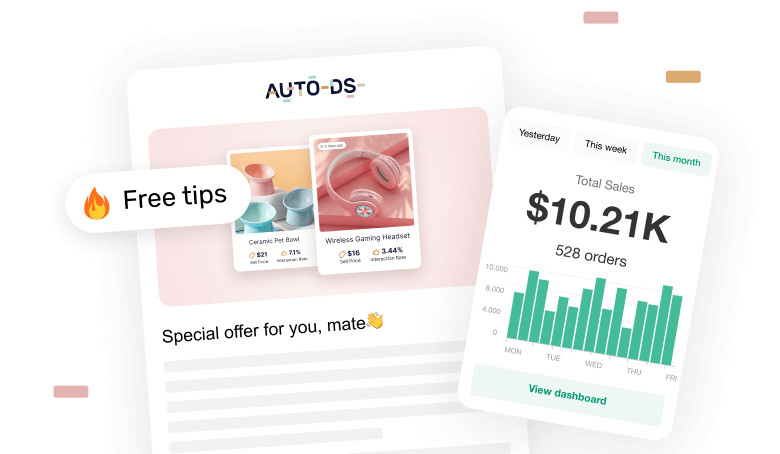Why Shopify Marketing Tools Matter in 2025
So you’ve built your Shopify store, added products, and even customized your theme until it looked perfect. But Shopify is not a Build-A-Bear; you can’t just dress it up and expect sales. To actually drive traffic and convert visitors into buyers, you need the right Shopify marketing tools.
In 2025, the e-commerce game is noisier than ever. TikTok ads can go viral in hours, Google’s algorithms keep evolving, and customers expect experiences that feel personal, fast, and trustworthy.
Here’s a quick fact to put things in perspective: according to Statista, global retail e-commerce sales are projected to hit $8.1 trillion by 2026. That means opportunity is huge—but only if you position your store with the right marketing stack.
And this is where AutoDS saves the day. AutoDS automates the heavy lifting (like product imports, stock syncing, and order fulfillment) so you can stay focused on running campaigns and growing sales instead of chasing logistics. So, consider this guide your all-in-one playbook for Shopify marketing success.
Shopify marketing tools help you cover the full funnel: traffic, conversion, and retention.
Free strategies like blogs, reviews, and interactive content are powerful starting points.
Paid tools such as Klaviyo, Judge.me, and Create UGC AI let you scale faster and smarter.
AutoDS helps you focus on marketing while it automates product imports, fulfillment, and pricing.
Shopify Marketing Ecosystem Overview
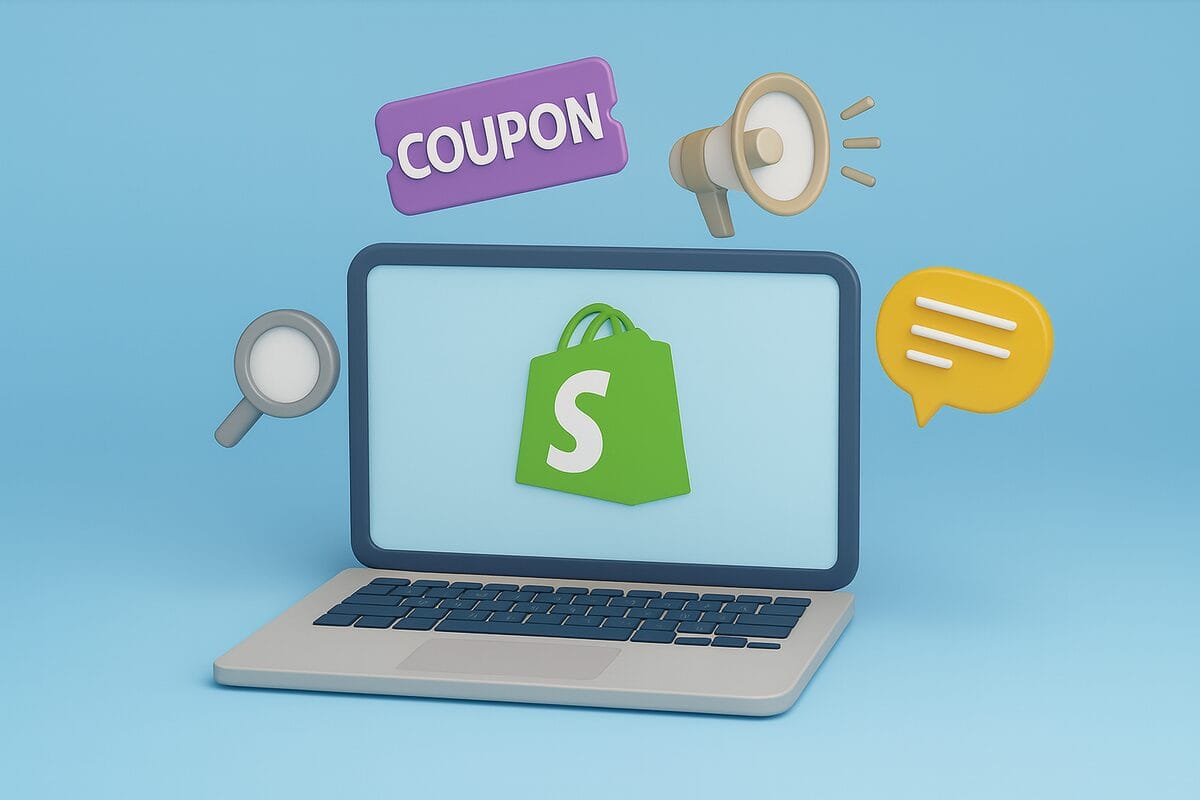
Before we dive into campaigns and creative strategies, let’s zoom out for a second, because Shopify is an entire ecosystem. And to succeed here, you need more than just products on digital shelves. You need a full marketing toolkit that covers traffic, conversion, and retention.
In 2025, the Shopify marketing landscape looks like this:
- Advertising Platforms: Paid ads on Facebook, Instagram, TikTok, and Google are still the fastest way to drive targeted traffic. The challenge? Rising ad costs and shorter attention spans mean you need smarter testing and stronger creatives.
- Search Visibility (SEO & SEM): Ranking high on Google or running targeted search ads ensures customers find you when they’re actively looking to buy. SEO is long-term fuel, while SEM is your instant boost.
- Content Marketing: Blogs, landing pages, and social posts give your store authority. Add UGC into the mix, and you’re not just talking at customers—you’re speaking their language.
- Email & SMS Marketing: Think of these as your direct line to customers. They drive repeat purchases and keep your brand top of mind.
- Customer Experience Tools: Reviews, loyalty programs, and personalization apps all help you stand out in a saturated market.
Now, here’s where things shift: while Shopify gives you the structure, the tools you layer on top define your growth. For example, AutoDS goes beyond logistics with AI-powered tools and fulfillment automation. Other tools, like Create UGC AI, solve one of the biggest 2025 marketing challenges (creating authentic content at scale) by generating ad-ready user-generated videos and images tailored to your products.
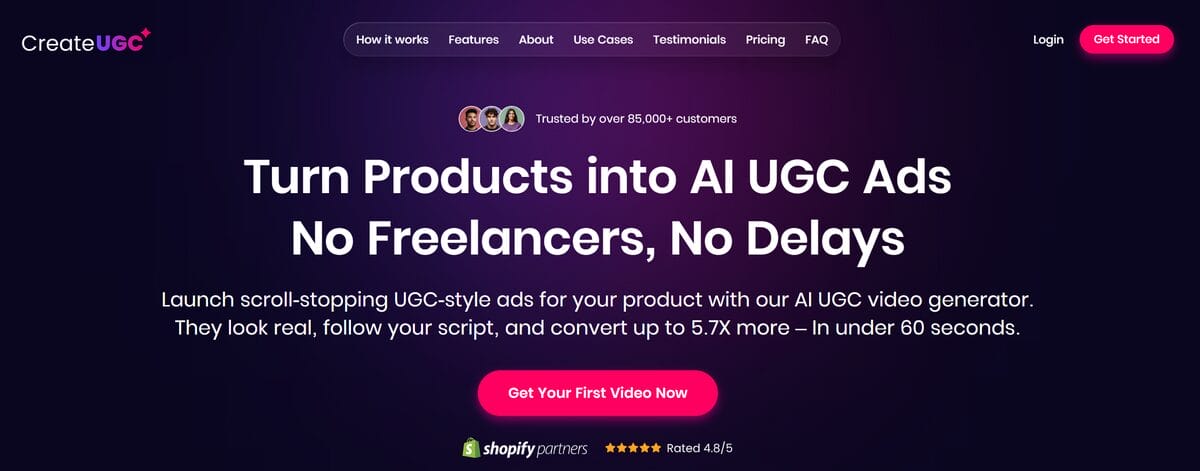
In other words, Shopify is the stage, but Shopify marketing tools are the spotlight, the sound system, and the hype crew that gets the audience clapping. With the right toolkit, your store becomes a brand people remember, trust, and keep coming back to.
Free Shopify Marketing Strategies
Before you start throwing money at ads, there are plenty of Shopify marketing strategies you can launch today. Your wallet can chill, these ones are free! They won’t cost you a cent, just a bit of creativity and consistency. The best part? Shopify already has built-in settings and free apps that make these strategies easy to launch.
- Offer Free Shipping. Even if you factor the cost into your product pricing, the word free creates a psychological push that makes buyers more likely to complete their orders. Shopify lets you set conditional free shipping (like over $50), so it’s strategic, not a money drain.
- Optimize Your Website. A slow, clunky store will kill conversions faster than a bad review. Use free Shopify themes, optimize product images, and double-check your mobile view. According to Google, 53% of users leave a site that takes longer than 3 seconds to load. Don’t let that be you.
- Start a Blog. Blogs may feel “old school,” but they’re SEO gold. Write about product benefits, comparisons, or how-to guides related to your niche. With Shopify’s built-in blogging tool, you don’t need fancy software—just consistency.
- Create Interactive Content. Polls, quizzes, or even “this or that” style Instagram stories don’t cost anything, but they skyrocket engagement. Think of it as giving your audience a chance to play with your brand instead of just scrolling past it. More engagement = better algorithm love.
- Ride Trends and Challenges. TikTok and Instagram challenges can put your product in front of thousands overnight. If you see a trending audio or hashtag like #TikTokMadeMeBuyIt, find a creative way to plug in your product. All it takes is your phone and a bit of boldness.
- Leverage Customer Reviews. Reviews are free content you didn’t even have to make. Use them for your product page optimization, social posts, or emails. Social proof is one of the strongest free marketing levers you have.
Building With Shopify Marketing Tools
Having a toolkit full of Shopify marketing tools is powerful—but only if you know how to put the pieces together. Think of your marketing stack like a toolbox: ads, email flows, SEO apps, and automation are all tools, but the way you combine and use them determines whether your campaigns actually convert.
Your marketing tools only work if your backend does. AutoDS syncs products, prices, and orders while you run campaigns. Try it now for $1, and you’ll never worry about overselling again.
Step 1 – Choose the Right Objective 🎯
Choosing an objective is like choosing a vibe check for your store: are we chasing clicks, clout, or cold, hard conversions? The first step of any campaign is deciding on its objective. Shopify makes this easier than ever with its built-in Marketing dashboard and integrations. Objectives usually fall into three categories: traffic, engagement, and conversions.
- Traffic-focused tools like SEO apps (Plug in SEO, Yoast) or Google Ads integrations help bring more visitors to your store. These are ideal if you’re just starting out or want to build brand visibility.
- Engagement-focused tools such as social posting apps, influencer platforms, or review widgets (like Judge.me) are perfect for creating buzz, generating likes, and building credibility.
- Conversion-focused tools—think AutoDS for automation, Klaviyo for personalized email flows, and upsell apps—help you turn browsers into buyers.
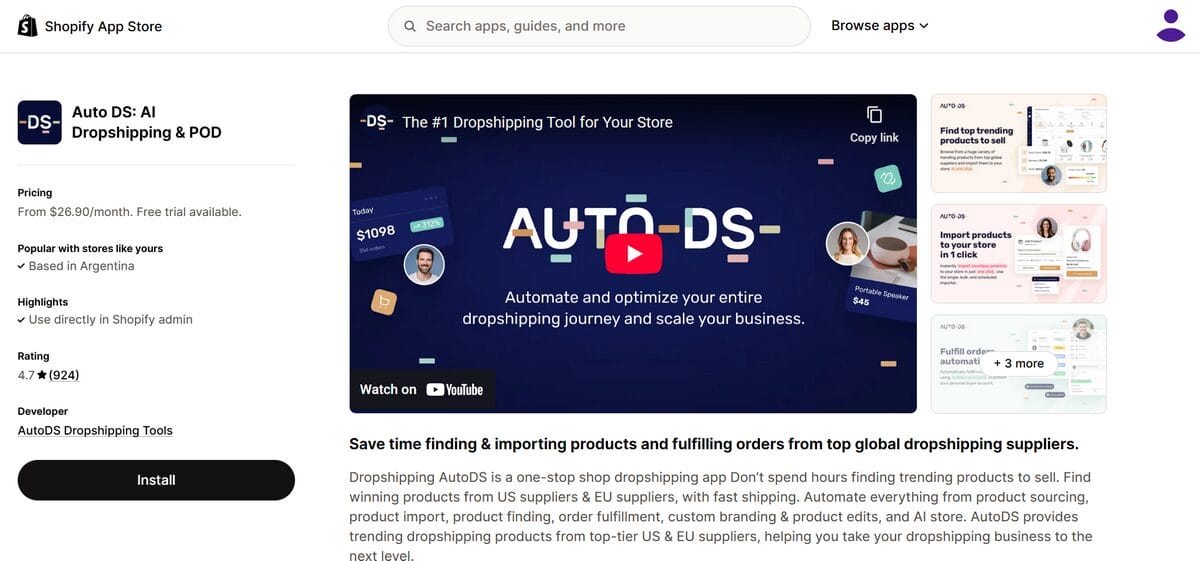
For Shopify stores, conversion should usually be your North Star. Tools like AutoDS ensure your backend (pricing, stock, fulfillment) is aligned so that customers can actually check out seamlessly when you launch campaigns. Use traffic and engagement campaigns as supporting roles, especially when you’re testing new products or trying to build social proof.
💡 Pro Tip: In Shopify’s dashboard, track your campaigns by mapping objectives to KPIs. If you’re running a conversion campaign, don’t just measure clicks—look at completed checkouts and average order value.
Step 2 – Set Up Targeting 👥
Targeting isn’t just for ads—it applies to every Shopify marketing tool you use. The goal is simple: get the right message in front of the right person. Translation: No, you don’t need to run an ad for kitchen knives to teenagers on TikTok. Platforms like Meta Ads Manager and TikTok Ads help with demographic targeting, but you can get even more precise with Shopify-integrated tools, like:
- Klaviyo and SMSBump let you segment email/SMS audiences based on past purchases, browsing behavior, or abandoned carts. Instead of blasting everyone the same offer, you can tailor campaigns that feel personal.
- AutoDS product research tools show you trending products and the buyer profiles most likely to convert. This gives you a starting point for building audiences across platforms.
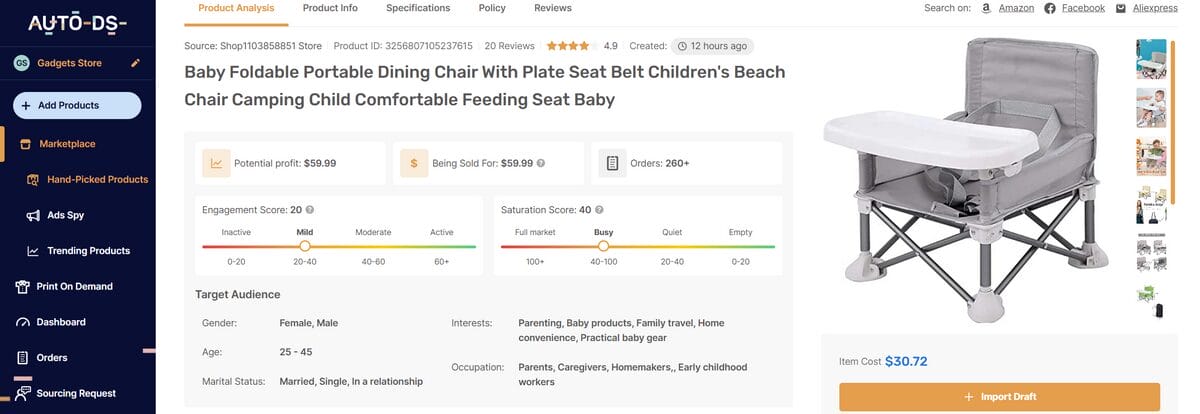
- Lookalike or custom audiences generated from your Shopify customer data (exported directly or synced through apps) let you expand beyond your current buyers and reach similar shoppers.
The smartest marketers combine platform targeting with Shopify data targeting. For example, run Facebook Ads to a lookalike audience while using Klaviyo to retarget past customers with personalized email sequences. This way, no matter where a shopper interacts with your brand, you’re delivering the right message.
🔍 Research Tip: When testing, start broad and let the algorithm optimize. Then, use Shopify analytics and AutoDS insights to refine.
Step 3 – Create Your Campaign Creatives 🎨
Your creatives—whether ads, emails, or on-site visuals—are the bridge between your product and your audience. This is where Shopify marketing tools shine, letting even small sellers produce polished, persuasive content.

- Create UGC AI is perfect for generating authentic, scroll-stopping videos and images that mimic the “user-generated” style consumers trust most. It’s basically like having an influencer on payroll—minus the sponsorship drama.
- Canva and Shopify design apps help you create branded assets for banners, social posts, and email campaigns.
- Review apps like Judge.me add customer voices directly into your creatives—turning testimonials into ad material or email snippets.
The key is to vary your creative angles. Test problem–solution ads, before–and–after visuals, and emotional hooks. Then, repurpose them across channels: the same video that brings in TikTok clicks can also be embedded in an email flow or your Shopify homepage.
Step 4 – Set Budgets & Track ROI With Tools 💸
Budgets are where many Shopify sellers panic. Should you spend more on ads, SEO apps, or email marketing? The answer depends on where you are in your store’s journey. Ad platforms give you budget controls, but Shopify marketing tools give you the bigger picture of ROI.
- For ads, start small—$10–$20/day is plenty for testing.
- For retention tools like Klaviyo or SMSBump, expect $30–$50/month as you scale your list.
- For automation (AutoDS), the monthly investment pays off by saving hours of manual work and syncing your marketing with fulfillment.
The trick isn’t just how much you spend, but how you measure results. Shopify’s analytics dashboard shows traffic, sales, and conversion rates. AutoDS analytics adds another layer by connecting ad performance to actual profits after costs, so you can see which campaigns are truly working.
💰 Financial Tip: Reinvest a portion of profits into your tool stack. If a product test goes well, allocate more toward Klaviyo for advanced flows or upgrade AutoDS to handle larger volumes. Tools scale as your store scales.
With a structure like this one, you’re not just “running ads.” You’re building a Shopify marketing system where objectives guide your campaigns, data powers targeting, automation supports creatives, and full-funnel analytics optimizes budgets.
How to Improve Marketing Performance Over Time
Launching your first campaign is exciting—but the real magic happens when you refine, scale, and optimize using the right Shopify marketing tools. Think of it as running a marathon: the launch gets you off the starting line, but performance tracking, smart adjustments, and tool-driven strategies are what get you across the finish line profitably.
What Metrics to Track
Metrics give you a clear picture of what’s working and what isn’t. On the ad side, you’ll want to track CTR (click-through rate), CPC (cost per click), ROAS (return on ad spend), and CPM (cost per thousand impressions). These tell you whether your campaigns are attracting attention and converting profitably.
But here’s where Shopify marketing tools make a big difference: ads are only one part of the funnel. With Shopify’s built-in analytics and tools like AutoDS profit calculator, you can see the full picture—including product margins, fulfillment costs, and net profit after expenses. Pair this with Google Analytics or Triple Whale for attribution clarity, and you’ll know exactly which campaigns, channels, or tools are pulling their weight.
💡 Pro Tip: Don’t just track ads. Monitor email open rates, review submission rates, and SEO rankings. These metrics are equally powerful in showing whether your marketing ecosystem is healthy.
Scaling Tips
Scaling is about finding what works across your entire Shopify toolkit and doubling down. Sure, you can increase daily budgets on winning ads by 20–30% or duplicate ad sets, but don’t stop there.
Smart Shopify sellers scale horizontally by expanding into new marketing tools:
- Add Klaviyo flows for abandoned carts and post-purchase upsells.
- Expand SEO efforts with optimized blog content to bring in free traffic long-term.
- Use loyalty apps like Smile.io to retain repeat buyers.
- Deploy Create UGC AI to generate fresh ad creatives and keep content pipelines full without burning out.
Scaling vertically means amplifying what already works. If TikTok ads are working, layer in retargeting emails. If blog SEO is ranking, repurpose those posts into Pinterest pins. The point is: scaling with Shopify marketing tools means building a multi-channel growth engine.
When to Reallocate Budget
If you’re spending on ads that aren’t converting after 3–5 days, pause them. But don’t just save the money; redirect it. Invest in SEO tools for long-term growth, or put more into Klaviyo to nurture the traffic you already captured. If CPMs are skyrocketing on Facebook, maybe shift some ad budget to TikTok, where costs are lower.
📦 Supplier’s Tip: Watch fulfillment times. If your ads are working but reviews start dropping due to slow delivery, your performance will tank. Use AutoDS Private Suppliers with fast U.S./EU shipping to protect your ROI.
Common Mistakes to Avoid (and How to Fix Them)
Cue the Taylor Swift soundtrack: ‘I can fix him—no, really, I can.’ That’s basically how most of us treat our Shopify marketing tools. The truth? Mistakes happen, but every one of them has a fix.
Mistake 1: Scaling ads too fast.
Scale budgets gradually and use AutoDS analytics to confirm profitability before doubling down.
Mistake 2: Ignoring retention tools.
Don’t just chase new customers—install loyalty apps, SMS tools, and review widgets to maximize lifetime value.
Mistake 3: Treating ads as the only growth channel.
Balance your spend with SEO apps, Klaviyo flows, and organic content. Ads bring speed, tools bring sustainability.
Mistake 4: Not tracking profit across tools.
Use Shopify analytics + AutoDS profit dashboards to see net results after costs. ROAS means nothing if margins aren’t accounted for.
Mistake 5: Sticking with one creative angle.
Rotate creatives using tools like Create UGC AI to keep performance fresh and avoid ad fatigue.
Creative Strategy Deep-Dive: Shopify Marketing Tools That Make Content Convert
Creatives are at the heart of every marketing campaign. Whether you’re running ads, sending emails, or posting organically on social media, the way you present your product determines whether shoppers scroll past—or stop and buy. In fact, a 2024 Nielsen report showed that creative quality drives up to 56% of sales lift in digital campaigns. That means mastering your creative strategy is just as important as picking the right product.
Most shoppers don’t land on your store ready to buy—they need to be convinced. That’s where marketing tools that shape your content and storytelling come into play. For example:
- Strong creatives boost CTR on ads and reduce CPC.
- Authentic visuals (UGC-style or reviews) build trust and credibility.
- Personalization tools increase conversion rates by showing the right product to the right person.
Shopify marketing tools in 2025 make this whole process easier than ever. From AI-generated content to review widgets and personalization apps, these tools help you craft authentic and persuasive content.
Tools That Power Creative Strategies on Shopify
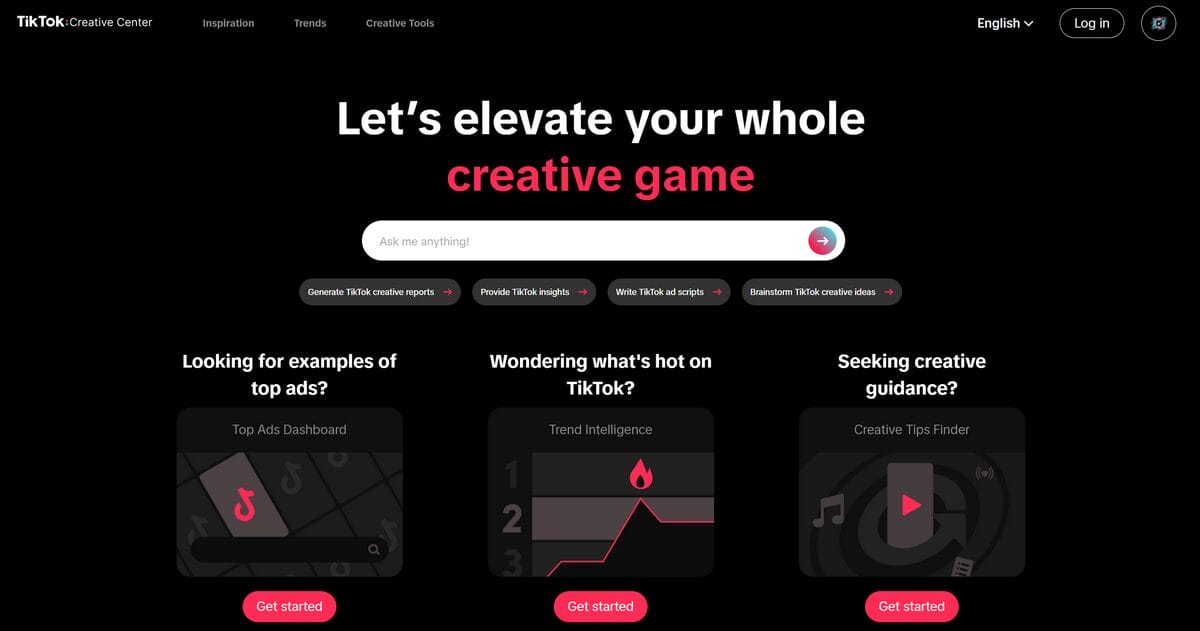
Here are some categories of Shopify marketing tools that directly enhance your creative output:
- Ad Research Platforms: TikTok Creative Center and Meta Ads Library let you study what’s working for other brands, so you don’t reinvent the wheel.
- Automation Platforms: AutoDS streamlines product descriptions, pricing, and fulfillment—so you can focus on testing creative angles instead of admin tasks.
- AI Content Tools: With Create UGC AI, you can instantly generate scroll-stopping ad creatives without hiring influencers or spending hours filming. According to Statista, 79% of consumers say user-generated content highly impacts their buying decisions.
- Review & Social Proof Apps: Tools like Judge.me display reviews, ratings, and even customer photos on your store, giving your creatives added credibility.
- Email & SMS Marketing Tools: Klaviyo or SMSBump let you add dynamic product visuals and personalized offers that look less like spam and more like curated content.
Creative Angles That Work in 2025
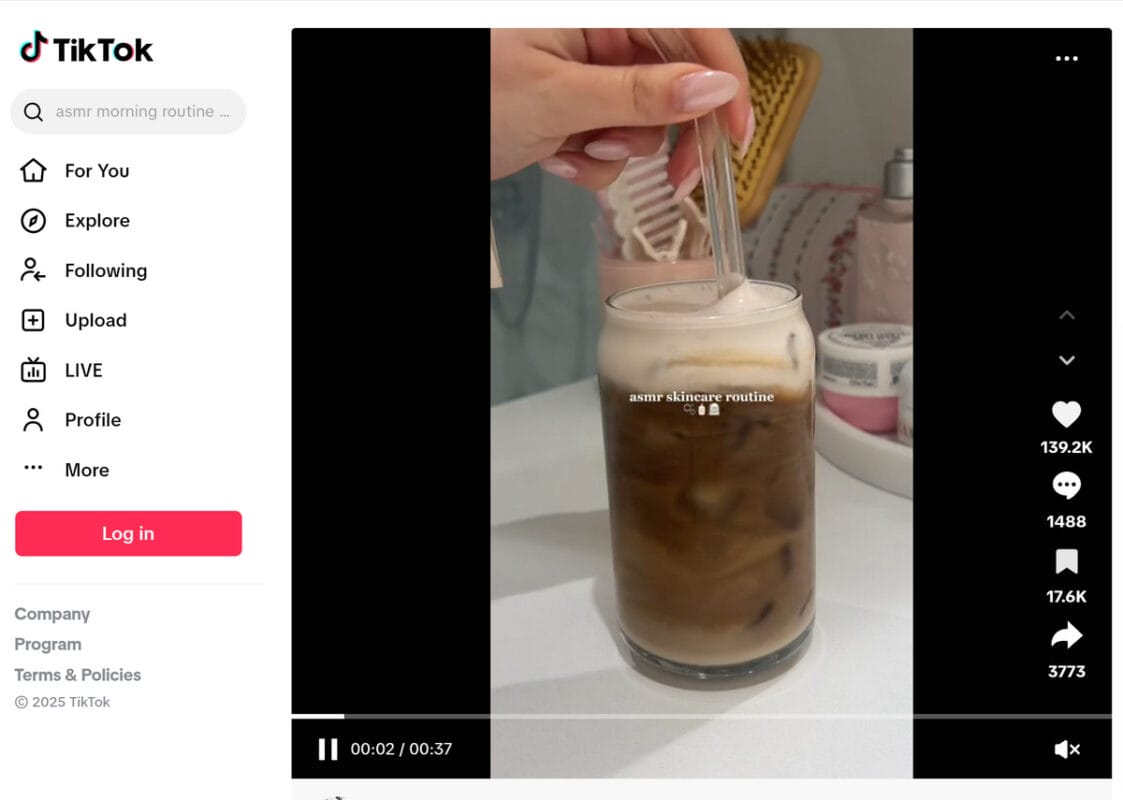
When paired with the right tools, these content angles help Shopify sellers stand out:
- Problem–Solution: Showcase a pain point and how your product solves it.
- Before–After: Highlight transformations (great for beauty, fitness, or home products). Think messy kitchen vs. sparkling clean (aka the marketing equivalent of a glow-up TikTok).
- Social Proof: Feature reviews or customer reactions.
- Educational Content: Quick how-tos, tips, or comparisons that position your store as a trusted guide.
- Seasonal Angles: Tie products to holidays, events, or trending topics on TikTok and Instagram.
The Future of Creatives for Shopify Sellers
In 2025, the line between ads and content is blurring. Shoppers don’t want polished, corporate-style ads—they want content that looks like it belongs on their feed. Shopify sellers who succeed are the ones using marketing tools to scale authentic creative production without losing quality.
AutoDS and Create UGC AI play a central role here: by combining automation with content generation, they let you test dozens of creative angles quickly, find what resonates, and scale with confidence.
👉 Bottom line: the smartest Shopify marketing strategies aren’t just about finding products—they’re about pairing strong creatives with the right tools so you can win attention, build trust, and convert faster.
Top 5 Shopify Marketing Tools For Your Dropshipping Store
Now, let’s dive into the top-notch Shopify marketing tools that can take your dropshipping store to the next level. Here are the five plugins that can significantly impact your online business.
1. AutoDS –All-In-One Dropshipping Solution

In the ever-evolving world of dropshipping, AutoDS emerges as an all-in-one Shopify marketing tool, redefining the way we approach and excel in the e-commerce game. In the first place, we’re talking about a tool that saves us countless hours searching for trending products while streamlining the entire dropshipping process, making it a breeze.
Not only does it work 24 hours a day to handle everything from product sourcing to order fulfillment, but it also leaves you more time to focus on what truly matters – growing your business. In addition, AutoDS ensures that you can swim the sea of dropshipping with ease. Coupled with its intuitive features, it becomes a valuable tool for entrepreneurs looking to stay ahead in the competitive world of e-commerce.
With the AI product title & description generator, we can create product titles and descriptions that include relevant and converting keywords to boost conversions. It helps boost SEO performance and rank higher on search engines like Google. Moreover, we can adjust the tone and temperature of our product titles and descriptions. Set the tone to be funnier, more professional, sellable, etc. The temperature can be more creative, precise, or balanced.
Plus, AutoDS’ solution guarantees:
- Comprehensive Product Sourcing: It is ideal to explore millions of premium dropshipping products with the added perk of custom branding, giving your store a unique edge in the market.
- Effortless Order Fulfillment: An opportunity to say goodbye to the manual hassle of order processing. AutoDS ensures that your dropshipping orders are seamlessly fulfilled, even when busy with other things.
- Smart Product Optimization: Enhance your product listings with intelligent optimization, covering everything from images and prices to titles and descriptions while making sure your offerings are irresistible to potential customers.
- Educational Hub – AutoDS Academy: AutoDS offers a wealth of knowledge through its Academy, providing free dropshipping courses, mentorship, guides, and eBooks, empowering dropshippers with the insights needed to thrive in the world of dropshipping.
AutoDS works as a strategic partner in facing dropshipping challenges and achieving success. It’s a very smart tool for dropshippers to consider when they’re looking to elevate their marketing game, boost their store’s efficiency, and embark on a growth journey.
2. Judge.me Product Reviews




In the e-commerce world, credibility is crucial. So, Judge.me emerges as a refined Shopify marketing tool to cultivate trust and boost sales through the influence of social proof. Offering a blend of functionality and aesthetics, this fast-loading, fully customizable review app is available in 38 languages. Basically, it’s a tool that facilitates the collection and display of product reviews and star ratings and serves as a robust marketing asset in your quest to establish authenticity and enhance conversion rates.
Judge.me can amplify your marketing strategy with:
- Automated Review Requests: Easily collect reviews by setting up automatic emails after customers receive orders. Encourage them to share their thoughts, photos, and videos effortlessly. As a result, this helps potential customers see the positive experiences others have had.
- Versatile Display Options: Present your star ratings, store and product reviews, trust badges, and a dynamic reviews carousel on your website. Also, you can take it further by sharing these reviews on popular social media platforms, creating eye-catching snippets for Google, and boosting your SEO ranking.
- Engagement Enhancements: Go beyond collecting reviews; engage with your customers personally. Answer their questions, offer exclusive coupons, and integrate with email marketing.
3. SMSBump: SMS Marketing & Email




We can’t argue that customer engagement is crucial to this business. That’s why Yotpo SMSBump emerges as a powerful Shopify marketing tool for driving revenue and sales through strategic SMS and email campaigns. In short, this solution lets you effortlessly expand your SMS and email lists, recover abandoned carts, and send impactful texts and emails that propel sales. With a user-friendly interface and many SMS templates, this app empowers you to engage with shoppers in real-time, ensuring each customer interaction is a revenue opportunity.
Yotpo SMSBump’s main benefits include:
- Versatile Campaign Crafting: Easily create, personalize, and test campaigns tailored for your text and email subscribers.
- Dynamic SMS Flows: Build SMS flows driven by real-time events and custom conditions, ensuring your messages reach your audience at the right moment. This real-time responsiveness enhances the effectiveness of your campaigns.
- Hyper-Targeted Segments: Effortlessly create hyper-targeted segments to engage specific subscriber groups.
- Transparent Pricing Plans: Flexible and transparent pay-as-you-grow SMS and email pricing plans.
4. UpPromote Affiliate Marketing




UpPromote is the go-to affiliate marketing solution, trusted by top brands and experts for its referral and affiliate program capabilities. Basically, this Shopify marketing tool works like having a powerful influencer marketing and referral program that wins hearts and garners trust through real testimonials. Users worldwide adore the simplicity of UpPromote’s affiliate marketing setup, providing everything needed, such as flexible commission options, automated coupons, and affiliate links. This solution empowers dropshippers to improve customer loyalty and creates a robust referral and rewards program. As a result, it acts as a booster for engagement with customers.
Its main benefits are:
- Brand Customization: Tailor everything to match your brand, from affiliate links and forms to the affiliate portal.
- Rewards and Discounts: Create exciting rewards and discounts within your customer referral program to encourage repeat purchases. In the end, this is an excellent strategy for fostering long-term engagement.
- Effortless Tracking: Seamlessly track referral orders through affiliate links, coupons, and connected emails.
- Motivational Options: Motivate affiliates with powerful incentives such as bonuses, gifts, store credit, and multi-level marketing (MLM) structures.
- Automated Processes: Automated affiliate program processes with tools like auto-pay and auto-tier commission structures.
5. Powerful Contact Form Builder




Step into the world of easy form creation with the Contact Form Builder app. This tool essentially allows building a Contact Us form or any professional-looking form without technical knowledge. Plus, it integrates with various third-party applications like Mailchimp, Klavio, Ominisend, Sendinblue, and Google Calendar. It’s an ideal option to keep in mind when looking for Shopify marketing tools. It displays custom forms effortlessly on various pages such as product pages, collection pages, cart pages, and the home page, offering versatility that caters to your business needs.
To summarize, it offers:
- Customer Account Registration Forms: Tailor registration forms with custom fields, offering a personalized touch to customer interactions.
- File and Image Upload Options: Create custom forms with file and image upload options.
- Autoresponder Emails: Send autoresponder emails effortlessly and integrate form data seamlessly with third-party applications.
- Versatile Form Types: Build various forms, from contact us forms with captcha to forms with condition logic. The app empowers you to create feedback, popup, wholesale order forms, and more.
How AutoDS Supercharges Your Shopify Marketing Tools


AutoDS is one of the best dropshipping platforms for Shopify stores. If your marketing stack is the engine, AutoDS is the transmission that makes every gear shift smoother—from first click to delivered package. Instead of rehashing imports and syncing, here’s what actually moves the needle when campaigns start scaling:
- Private Suppliers & Fast Routing. AutoDS connects you to Private Suppliers with US/EU stock and smart geo-routing, so ad promises match real-world delivery. It reduces delivery friction that kills conversion after the click.
- Fulfilled by AutoDS (Hands-Off Ops). AutoDS can place, track, and update orders automatically—even across multiple suppliers—so email/SMS flows always show live tracking and your CS replies stay on brand and on time.
- Rules-Based Pricing & Safeguards. Set profit floors, MAP limits, and dynamic markups tied to cost changes. When CPMs spike, AutoDS protects your margins instead of letting promo campaigns sell at a loss.
- Profit-First Analytics. Tie product costs, shipping, taxes, and fees to actual sales. AutoDS surfaces true profit per SKU, so you can kill losers fast and pour spend into proven winners.
- AI-Powered Optimization Tools. From the AI Shopify Store Builder that sets up a storefront in minutes to the AI title & description generator that creates SEO-friendly copy, AutoDS brings creative automation right into your marketing workflow.
Bottom line: AutoDS turns your Shopify marketing stack into a closed-loop system—ads drive demand, and AutoDS turns demand into profit, reliably.
Your all-in-one Shopify marketing sidekick ▶️ Test 14 days of AutoDS for just $1 today.
Frequently Asked Questions
What are Shopify marketing tools?
Shopify marketing tools are apps, platforms, and features that help you attract visitors, run campaigns, and convert them into paying customers. They cover everything from SEO and email automation to paid ads and content creation. Tools like Meta Ads Library and TikTok Creative Center help you research ad strategies, while all-in-one solutions like AutoDS combine product research, fulfillment, and pricing automation. Tools like Create UGC AI are perfect for ready-to-use ad creatives.
How much should I spend on Shopify marketing tools when starting out?
The good news is that many tools have free plans or low entry-level pricing. For example, you can get started using free SEO apps, starter email marketing plans, and even AutoDS’s low-cost trial. Most beginners invest around $50–$100 per month on tools to cover essentials like email, reviews, and automation. You can scale into paid ad platforms and advanced analytics as your store grows.
What are the best Shopify marketing tools to grow a store in 2025?
The most effective Shopify Marketing Tools cover multiple stages of your funnel. For ads, TikTok Creative Center and Meta Ads Library help you study competitors and spot winning creatives. AutoDS stands out as an all-in-one solution for automation, handling everything from product research to fulfillment and price updates. On top of that, Create UGC AI lets you generate authentic, ad-ready content without hiring influencers or filming manually.
Shopify Marketing Tools will boost your Shopify store
Choosing the right Shopify marketing tools to support every stage of your funnel is essential in 2025. From researching products to testing creatives and scaling campaigns, the tools you use determine how fast and how far your store can grow. While TikTok Creative Center, Meta Ads Library, and email apps all play their part, automation is what ties everything together.
AutoDS helps you focus on marketing while it automatically handles product uploads, pricing, and order tracking. It transforms Shopify marketing tools into a complete growth system. Instead of juggling dozens of apps, you get one streamlined solution that lets you scale smarter and faster.
👉 Ready to implement your toolkit? Read our recommended articles below to learn more about Shopify marketing tools and dropshipping success strategies.






